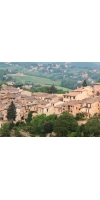Wine from Umbria

The Green Heart City in Italy, also known as Umbria, is one of the smallest wine regions in the country. Quaint medieval villages and lush green hills surround the region. The fourth smallest wine region in Italy, the region produces almost a third of the wine that the Tuscany does and has been overshadowed by Marche, Latium, and Tuscany. With that being said, Ubrian wines are becoming much more respected and known around the world.
The history of Ubria’s wine making history started with the Benedictine monks they first started planting grape vines in the sandy and calcareous clay soil that the region is known for. The climate in the region is similar to Tuscany and enjoys dry and sunny summers, and cold and rainy winters with the exception being the area that surrounds Lake Trasimeno and Lake Bolsena, which is dominated by mild and Mediterranean microclimates.
A blend of four and sometimes five grapes, one of the best known Italian whites that is produced around Ubria is known as Trebbiano Toscana, Verdello, Grechetto, and Canaiolo Bianco, known also as Drupello, or Malvasia Toscana
Umbria is known around the globe as the land of the saints and includes San Benedetto, San Feliciano, San Fortunato, and San Francesco d’Assisi.
Falesco focused on the expression of a young red with explosive and succulent aromas. The wine has a magnificent, intense and deep ruby red color, important and solid in its organoleptic ensemble. Rich in polyphenolics, but also with a balanced freshness and acidity, this wine is versatile, innovative and immediately drinkable. Very flexible for food combinations, to be enjoyed in the clear fragrance of its aromas and in the expression of its character.
- back
Selected Options
Regions
Categories
Pricing
Countries
Regions
Grape Types
Wineries
Organic/Free Shipping
A balanced and memorable Chardonnay that starts with aromas of orangeblossom, Asian pear, crème fraiche, peaches and chamomile, complemented bynotes of toffee, honeysuckle, and graham cracker. On the palate, flavors of greenapple, Meyer lemon and stonefruit are finished with notes of tangerine and vanilla.This Chardonnay is smooth, creamy and balanced with a lingering acidity and a longfinish. This is the perfect wine to pair with a brie or gouda cheese plate drizzled withlocal honey and hazelnut.
Review:
Fruit is sourced primarily from the southern part of Napa Valley, and aged five months in French oak. With its billowy mouthfeel, the liquid seemingly floats above the palate. Lemon curd, daffodil, cinnamon toast, and creamy vanilla sandalwood are delicious and generous flavors. This is approachable luxury. - The Tasting Panel, July/August 2025
-Tasting Panel/Somm Journal 92 Points
Holocene Memorialis Pinot Noir is made from 100 percent Pinot Noir.
Holocene Pinot Noir Memorialis is a blend of 777, Pommard and 115 clones from MonksGate vineyard in the Yamhill-Carlton AVA, and it saw about 20% new French oak for 16 months prior to bottling. It is always the lighter and more feminine of the two Holocene wines, with red fruits, white flowers, dried herbs, mushroom and forest floor aromatics, bright acidity and a lithe texture, long finish.
By now, everyone knows that the Willamette Valley is an amazing place to grow Pinot Noir. When I relocated from Napa Valley to partner up with Force Majeure Vineyards, I knew I also wanted to start a project where I could focus attention on a varietal and growing region that I loved. Part of the excitement of being in the Pacific Northwest is the ability to have access to so many amazing vineyards and so much diversity, along with the opportunity to push boundaries and try new things – something that is becoming increasingly difficult in other growing regions.
We partner up with a few very small, diverse and amazing vineyards in the Willamette Valley, sourcing fruit from these dry-farmed sites that emphasize low yields, sustainable practices and produce outstanding fruit.
The wines are crafted in the same way I have been making wine since I was carrying it out at Bryant Family Vineyard in the Napa Valley — utilizing very low-impact, non-industrial techniques, native yeasts, little extraction and little new oak, and never filtering or fining. This allows a real sense of place to show through in the wines that is often dimmed when too much manipulation is undertaken.
Our first vintage was 2015, and was released in early 2017. As production is currently extremely small, the best way to get the wines into your hands is to join our mailing list at the “Mailing List” link above to receive an allocation when we have a release. We release wines once per year, and they will be sold on a first come, first served basis, shipped straight to your door.
Review:
"A Bing cherry aroma slinks its way up from the glass, followed by spicy whispers of cardamom and cinnamon. Straw and chalkboard dust scents seal the deal. After a tannic black tea note materializes on the palate, the wine's cranberry and raspberry flavors punch the tart button. You can feel the tannins, but they aren't grippy. The acidity, however, lets you know it is ready for juicy business. Memorialis is quietly becoming one of Oregon's best Pinot Noirs. — Michael ALBERTYS"
- - Wine Enthusiast (October 1st 2025), 98 pts & Editor's Choice





